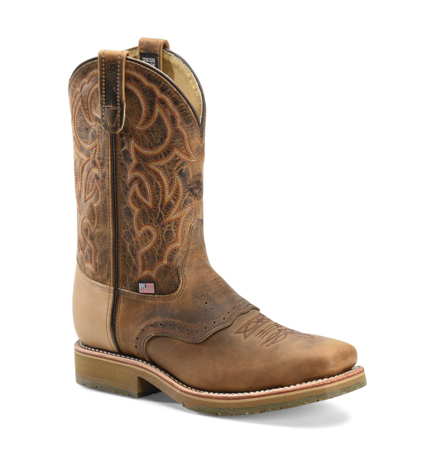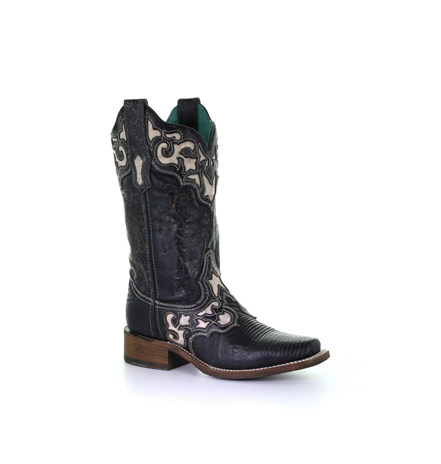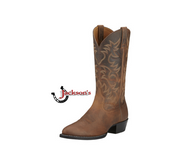Heel, Toe, and Shaft: What Makes Up a Western Boot
Posted by Jackson's Western Store on Jun 04, 2020
Frontier living is hard living, as is the life of a rancher or farmer. The earth and the elements are unforgiving, and not just at any one time of year. In the summer the sun is unrelenting and can cook exposed skin. The winter gives no solace, though, as the winds and snow bite as fiercely as the sun. At any other time of the year, a person living on the plains might have to look on drought and driving rain with equal stoicism, and they relied heavily on their grit.
Cowboys in the past, and ranchers today, have to contend with these environmental factors still, though they are not the only things that can test the mettle of a working man - or woman. Those who make a living in the fields also have to put up with long hours on their feet in rough conditions as well as tough work, day in and day out. Grit and determination get them through this too, but it’s not the only thing that carries them. They also have the benefit of the specialized clothing that they wear that helps accommodate their lifestyle as well as protect them from it.
While a felted fur hat might have become a fashion statement in recent years, as a big belt buckle or a high pair of cowboy boots, these staples of western wear have their roots in function, not form. It just so happens that in addition to being protective and supportive, they are also stylish.
Cowboy boots, and all of western wear, evolved over time to fill very specific needs of the people who wore them. Chaps and jeans protected a rider’s legs as he traveled through scrub and brush. Some western shirts had wide sleeves to give the wearer a large range of motion and flexibility. A western hat kept the sun off a wearer’s neck and shoulders and out of his eyes. The best ones were even waterproof. Western boots, similarly, offered a range of protection to the people that wore them.
There might not be a more quintessential piece of western wear than a cowboy’s boots. Cowboy boots and other western boots are, in their own right, an actual metonym for the cowboy in specific or the west in general. But if those classic cowboy boots are not just a staple of fashion and have their origins in function, where did they come from, and why do they look the way they do today?
A Short History
The origins of the ‘first’ cowboy boots are obscure, but historians are pretty sure they have identified some predecessors that, at the very least, influenced their development. Ultimately, the need for footwear designed for riding has been more influential than anything else on the development and history of cowboy boots, though there were other factors.
For example, culture and the availability of materials were also influential in the development of cowboy boots. The thing is, people have been riding horses for thousands of years - before the keeping of records, so tracing the influences here is not fully precise. However, there is plenty of reason to trust in a large number of these accounts.
The primary purpose of cowboy boots is to protect a rider's feet and legs while at the same time incorporating features that made it easier for a cowboy to mount a horse, control a horse and stay in the saddle.
One of the earliest designs that bears a recognizable resemblance to modern cowboy boots and had a similar purpose was the design of the Wellington Boot. Wellington Boots, so named because they were worn and popularized by a Duke of Wellington, were very high leather boots that horsemen wore to protect their feet and lower legs while they were riding. Riders from Europe brought the design to the New World where it quickly spread in popularity because it was protective and practical.
Riders in the United States Army adopted this style and it spread west through the country. While it can’t be said if the influence of the United States or other European influences to the south brought the design into contact with westerners and Mexican horsemen, they quickly adopted the design. Alterations of the Wellington style boot quickly became popular among the herders, ranchers, and horsemen of the Southwest because of a number of features that made them ideal for riding. With a few simple alterations that have stood the test of time, we’ve come by modern cowboy boots.
Just about every feature of a pair of western boots is designed to facilitate riding and offer a greater level of protection. Here is a breakdown of some of the parts of western boot, why they are shaped the way they are, and what their specific purpose is.
The Toe

Starting from the bottom up, the toe is the first part of a cowboy boot that plays a role in its function. While today, you are just as likely to find a pair of Ariat square toe boots as you are to find a pair of Tony Lamas with pointed toes, many of the original cowboy boots had pointed toes and for a very good reason.
Whereas many shoes today boast of pointed toes, wingtips, and square toes for cosmetic reasons, the same cannot be said of cowboy boots. Their toes were almost always pointed because the people that wore them had to get into and out of a saddle day in and day out. And with getting into and out of the saddle comes getting your feet into and out of the stirrups. The pointed toe of most cowboy boots was so designed with this in mind.
The reason for this near universality is quite simple. The point-toe makes it easier to get your foot into a stirrup. That being said, a common alternative to the pointed toe boots you will find are square toe boots which serve a different, albeit less historical, purpose. Simply put, square toes are more comfortable for some people. With more room in the toe box, you have a lot more room for your feet, and if you are wearing cowboy boots as a fashion statement, then the pointed toe becomes less necessary. Dare we say that some square-toed boots look quite dashing as well.
While most people will generally categorize the toes of boots as rounded or square, there are other distinctions that can be drawn on a finer scale. When it comes to rounded or pointed-toe boots, some are classified as having a D, R, or J toes. Boots with an R toe are similar to wingtips, with D and J toes being the most pointed.
Rest assured, whether you were looking for a traditional cowboy boot with a pointed toe or a pair of Ariat square toe boots, you can find them right here.
The Sole
Traditionally, cowboy boots have been made with a leather sole, although today some modern boots are made with rubber. There are benefits of each, so we’ll start with the traditional approach.
Since the primary function of the first cowboy boots was to make riding easier, the slick leather soles they came with were ideal. They easily slid in and out of the stirrup along with the pointed toe of early boots. Better yet, once you wear a pair of slick leather soles and rough them up, they offer great traction on the ground while still being easy to get in and out of the stirrup.
However, modern rubber soles tend to offer better traction on most surfaces than leather soles, particularly man-made surfaces like asphalt. On the flip side, that can be very stubborn to get in and out of a stirrup as the rubber tends to grab onto the metal.
As with the different types of toes, you can find boots at Jackson’s with both leather and rubber soles. What you choose to use is up to you, as they are both good for different purposes.
Heel
The heel, though in a way is a part of the sole, deserves its own category here because of how specifically it was designed to help keep a rider in the saddle and in control of the horse. There are riding heels, cowboy heels, fowler heels, and roper heels, among some others, and each of these different styles offers a sharp rise above the forward part of the sole, although riding and cowboy heels represent this the best.
Cowboy boots usually had a riding heel or a cowboy heel with a forward slant. Though they are eye-catching and an important part of the boot, they had nothing to do with fashion. Consider this - you can still find these customary bootheels on modern work boots, where the function is to keep the person steady on the rungs of a ladder.
For a rider, the heel provided a lot of grip at the base of the stirrup and prevented the foot from sliding too far forward in the stirrup. The amount of control this gave the rider is truly impressive and there is a noteworthy difference between boots that offer a sharp heel and those that don’t.
To summarize; though you can find many styles of cowboy boots available today, most early designs had a sharp, forward angled heel that helped them grip the stirrup. You can still find many traditional pairs of boots offering the same feature as a part of their design.
Vamp and Shaft

The vamp and the shaft of cowboy boots provided just the same level of function in their design as the other features of the boot to which we have called attention thus far. Often made from leather, the vamp and shaft of cowboy boots protected the feet as well as part of the shins of riders against abrasion and injury.
Leather, especially full-grain leather, is a remarkably resilient material that is soft, pliable, and breathable while still being amazingly protective. Of course, these were some of the reasons that early boots were made with leather. However, nowadays you can find cowboy boots with uppers of all different types of skins and other materials. Today, however, the chief purpose of this is cosmetic.
Even though the upper of a cowboy boot was instrumental in protecting a rider’s feet and legs, there’s more to the design than this. You may have noticed that cowboy boots never have laces, whereas many other styles of boots do. This is not because they are unnecessary - it is actually because they are unhelpful.
Laces on riding boots are at best an inconvenience and at worst a danger to the rider. Laces can catch on other parts of the tack, making it difficult to mount and dismount. Worse yet, they can catch on obstructions that are a part of the terrain through which the rider is traveling, which can injure a rider or pull him from the saddle. That’s why you never see laces on western boots, even today.
As you can see, each feature of a pair of western boots is firmly rooted in utility, and each serves its own purpose in making it easier for a rider to mount, dismount, and ultimately, to ride a horse. Today they may have become a fashion statement, but there is a very good reason for their customary styling.
Take a look through our catalog of men’s boots , women’s boots and boots for children that you will find here on our site and you will see plenty of classic examples of western boots. Whether you want a pair of Ariat square toe boots for work or a pair of Ariat boots with pointed toes for riding, you can find them in our store. In addition, if you come to visit us in our retail location, you can take advantage of our complimentary booting fitting and stretching services so that your boots are good to hit the trail with you the minute you leave the store. Check out our product pages above and give us a call at 269-792-2950 the next time you have a chance so you can plan your trip.

